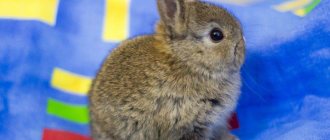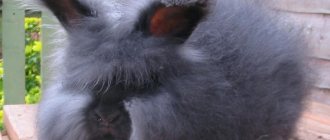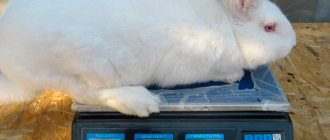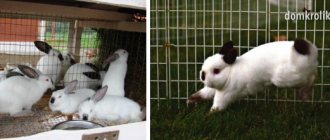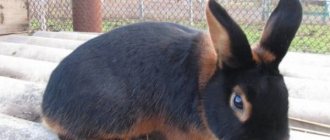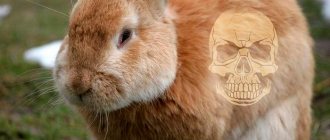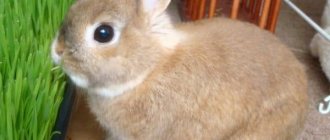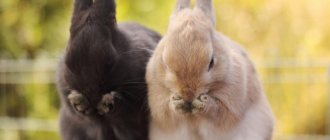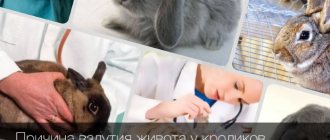Highly productive breeds of farm animals, as a rule, are very demanding in terms of living conditions, while indigenous breeds are very unpretentious, but have low productivity. For this reason, it can be very difficult for novice farmers to choose a breed that would not require deep knowledge and experience in care, but would still give acceptable results. The Californian rabbit is precisely such a breed, which is distinguished by both good productivity and moderate requirements for living conditions.
Origin
The California breed of rabbits was bred by breeders in the USA, and came to Russia in the seventies of the last century and gained great popularity here . The following breeds were used for crossing: New Zealand White, Soviet Chinchilla and Russian Ermine breeds.
Breeding work was carried out with the aim of obtaining a new breed with good quality fur and early maturity. In addition, the resulting species is capable of producing a lot of tasty and healthy meat with a low fat content. Also read about the Ameraucana chicken breed here.
Description of the breed
Rabbits of the Californian meat breed have an unusual, characteristic skin color, which is why they are valued for their good decorative qualities. The color of their fur is white, the shade of their ears, paws, nose and tail is dark brown. The eyes of individuals are usually red.
The animals have a small head, a humped nose and erect ears. Rabbits have short necks and legs, a regular build, and a wide chest. The large amount of meat that can be obtained from them is explained by the compactness of the body and strong muscles.
Young animals, as a rule, are born completely white, and characteristic dark brown spots on their bodies appear as they mature. Representatives of the breed often participate in exhibitions.
Choosing the right Californian
Let's look at a few tips. They are given by experienced farmers and livestock breeders regarding the choice of rabbits.
- It is advisable to choose animals from smaller litters.
- Each individual must be carefully examined.
- A healthy rabbit is well-fed and mobile.
- The eyes are clear and clean.
- The coat is smooth, attractive with its thickness and shine, and quite clean.
- It is worth paying attention to the problem of incest. When you need to buy several females, they must belong to different nests.
- If a rabbit's belly is bloated and its fur is dull, the rabbit is discarded.
- The nose should be clean and free of discharge. It's bad if a rabbit sneezes.
- The ears are also carefully examined. In healthy animals they are clean, without discharge or inflammation.
- Activity and emotional mood are also extremely important. A healthy individual is inquisitive, not timid, has a friendly attitude and makes contact with humans. Rabbits should not be shy or passive.
Remember all the recommendations, try not to miss a single detail so that your purchase is as profitable as possible.
Rabbits of different ages
Nuances when choosing Californians
We will also list the characteristics of the breed, thanks to which individuals become so recognizable.
- The skin is generally light, but the tail and legs are brown.
- The muscles are well developed.
- The animal has a hooked nose.
- The head is small.
- Ears stand straight.
Typical of the breed
These are simple signs by which you can instantly distinguish a California rabbit. Then it is extremely important to remember those characteristics that have become key to culling individuals. We are talking about selecting adult animals for further breeding. These are the signs a rabbit is rejected for:
- There is an excessively large spot on the nose.
- Eye color is different from standard.
- The fur is not elastic enough, it is rare.
- There are extra dark spots on the animal's body.
- The ears are not erect, excessively long.
- The individual weighs more than 5.5 kg, or less than 3.5 kg.
When everything is in order, there are no such disadvantages, you can consider the animal a breed standard and take it for breeding.
Video - The difference between a purebred Californian rabbit and a mixed animal
Breed productivity
Adult rabbits reach a weight of five kilograms. By two months after birth, rabbits can weigh two kilograms, and by five months they can be prepared for slaughter. At this time, their intensive growth ends and the bulk begins to gain . It is noteworthy that after the rabbits are weaned from their mother, the young animals grow faster than representatives of many other breeds. In a year, female rabbits give birth to about thirty-five babies, seven or eight for each litter. Read about breeding and caring for a Rex rabbit here.
Meat from breeds such as Californian, Silver and Gray Giant has low fat content. Moreover, more than eighty percent of their body weight with high-quality fattening is directly the meat part. The downing index is more than sixty percent, which indicates the high degree of profitability of keeping rabbits. At the same time, animals consume relatively little food.
Cage for adult rabbits
Rabbits grow and over time the size of the cages needs to be increased. The parameters of the home for adult individuals should be: length - 140-150 cm, height - about 50 cm, width - 70-80 cm.
Females will also need large cages during the litter period. The suitable size is as follows: length – 100 cm, width – 70-75 cm, height – 60-65 cm.
In spacious living conditions, an adult will have its own space, which will give a feeling of freedom. Experienced farmers are convinced that the floor should be either mesh or slats.
veterinarian - the answer will be sent to your email
Maintenance and care
California blues, like Vienna blues, easily adapt to the proposed environmental conditions and climate, thanks to which they can be bred almost throughout the entire territory of Russia. The thick fur that covers almost the entire body of animals allows them to be kept in cages without a solid bottom, which is very convenient for reasons of hygiene and the prevention of common infections. In addition, rabbits do not require a large room; half a meter of space for each individual is enough. Approximate volume of individual cells: sixty centimeters in width and height plus one hundred and twenty centimeters in length. They can be made using lattice, wood, plywood. Pits are also suitable for maintenance. In this case, it is advisable to make a mesh or wooden floor.
An example of a cage for rabbits
During the warm season, rabbits can spend most of their time outside. You can build a separate enclosure or paddock for them. However, it is important that there is also a canopy that will protect the animals from precipitation and sunlight. Feeders should be securely fastened to the floor so that they cannot be overturned or moved. They should be cleaned daily. Bedding made of hay, straw or sawdust also needs to be replaced every day.
Also read about the Krasnogorbatovskaya breed of cows at this link.
In shared enclosures, it is best to stock rabbits of approximately the same age. At the same time, it is highly not recommended to allow closely related relationships, since this can lead to mutations and degeneration.
Cage sizes for California rabbits
Cages for Californian rabbits are mainly manufactured in groups. There are one-, two- and three-tier ones. There should be at least 35 cm from the ground to the lower tier. In cold times, when babies require special care, a 20 cm layer of straw is laid on the floor. Such cages are used for placing young animals. They can contain up to 20 individuals.
Important! The area per individual must be at least 0.5 sq.m, and the height is 35 cm.
It is advisable to make the cages from natural materials, and make the floor mesh - this will protect against parasites and infections.
Feeding
Feeding rabbits does not follow any special regime. The basis of the diet usually depends on the season, as well as periodization. When fattening for slaughter, the amount of food increases, and the most high-calorie and saturated foods are used.
In the warm season, the basis of the diet is vegetables (cabbage, root vegetables, cucumbers, melons), fruits, combined feed and grain crops, succulent herbs. In winter, as a rule, it is recommended to give preference to concentrates and seasonal root vegetables, hay, and grass dust. At any time of the year, it is useful to supplement your diet with dairy products, as well as vitamin and mineral premixes, chalk, meat and bone and fish meal. Be sure to always have clean water and rough food in the room to wear down your teeth.
Approximate calculation of the diet of rabbits
Drinkers and feeders must be cleaned daily. It is recommended to disinfect them once a week to prevent various infections.
Breeding
In order to get a large number of young animals, it is enough to purchase four female rabbits and one male. Young individuals can be mated as early as five months after birth. Moreover, the average life expectancy of animals under ideal conditions is ten years. Also find out about the Pavlovsk breed of chickens in this material.
The duration of gestation for rabbits is about thirty to thirty-five days. It is better to keep the rabbits in separate enclosures for the last week before giving birth. At this time, they are able to show aggression and behave restlessly.
The milk period for baby rabbits ends at the age of three months. At this time, it is necessary to gradually introduce concentrates, grain and meat and bone meal, as well as greens into their diet. Until the rabbits reach five months of age, they must be periodically examined for possible abnormalities and pathologies. It is also important to get vaccinated in a timely manner.
The birth of a female rabbit occurs on days 13-15
An important measure to prevent degeneration is the renewal of young animals. In order to accommodate new individuals that are not related to existing ones, it is recommended to contact a rabbit farm or livestock farm. You should definitely pay attention to the fact that the farm is large enough, since in this case the probability of having at least two lines there is higher, which means there will be no closely related ties between the rabbits. Find out about keeping a Butterfly rabbit at home in this article.
Each time it is recommended to contact different organizations to prevent incest. However, any farms must be verified.
conclusions
When raising and breeding rabbits of the Californian, New Zealand and Burgundy breeds, first of all, you need to pay attention to their nutrition and living conditions. Basic rules of hygiene and cleanliness must be observed in the premises, and the diet must be balanced. Incest should also not be allowed, as this can lead to degeneration and a sharp decrease in productivity. If you follow these rules, you can get high-quality fur of an unusual color and excellent tasty and healthy meat.
Disease resistance
California rabbits have a fairly strong immune system. But with improper feeding, poor hygiene and violation of the vaccination schedule, representatives of the breed develop health problems.
Californians are prone to the following diseases:
- Bronchitis, rhinitis, pneumonia. These diseases develop if rabbits are kept in damp, drafty areas. All of them require drug therapy.
- Inflammation of the soles of the feet. This disease occurs as a result of untimely trimming of nails, infrequent bedding changes, or being kept on an uncomfortable mesh floor. It is treated with rinses, antibiotics and ointments.
- Bloating. Occurs as a result of improper feeding and can be fatal. It is treated with special massage, medications and herbal decoctions.
- Viral hemorrhagic disease. Leads to the death of the animal and is transmitted through contact with an infected rabbit or through equipment. The disease can only be prevented through timely vaccination.
- Myxomatosis. It is transmitted through the bites of blood-sucking insects and through direct contact with infected animals. It cannot be completely cured and in 30-70% of cases leads to death.
